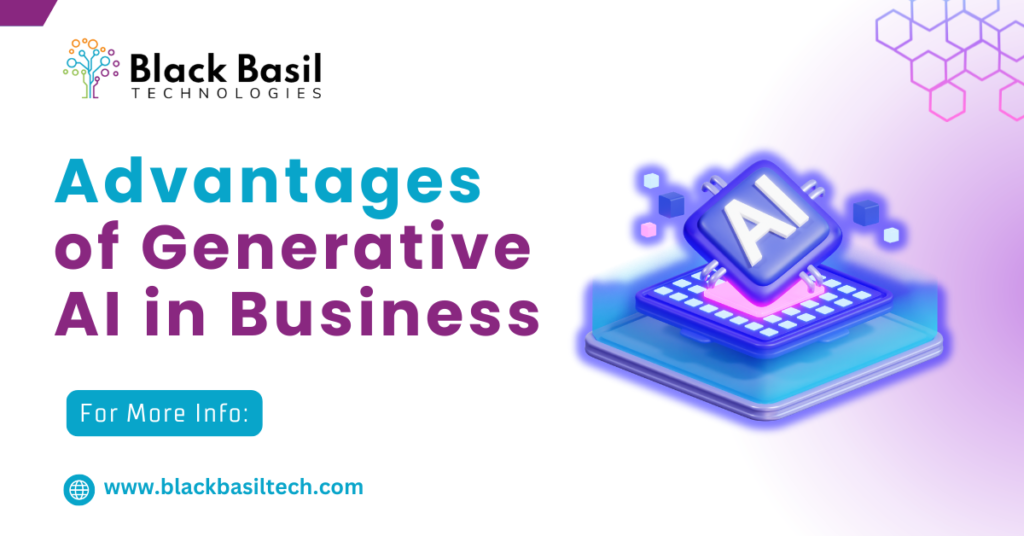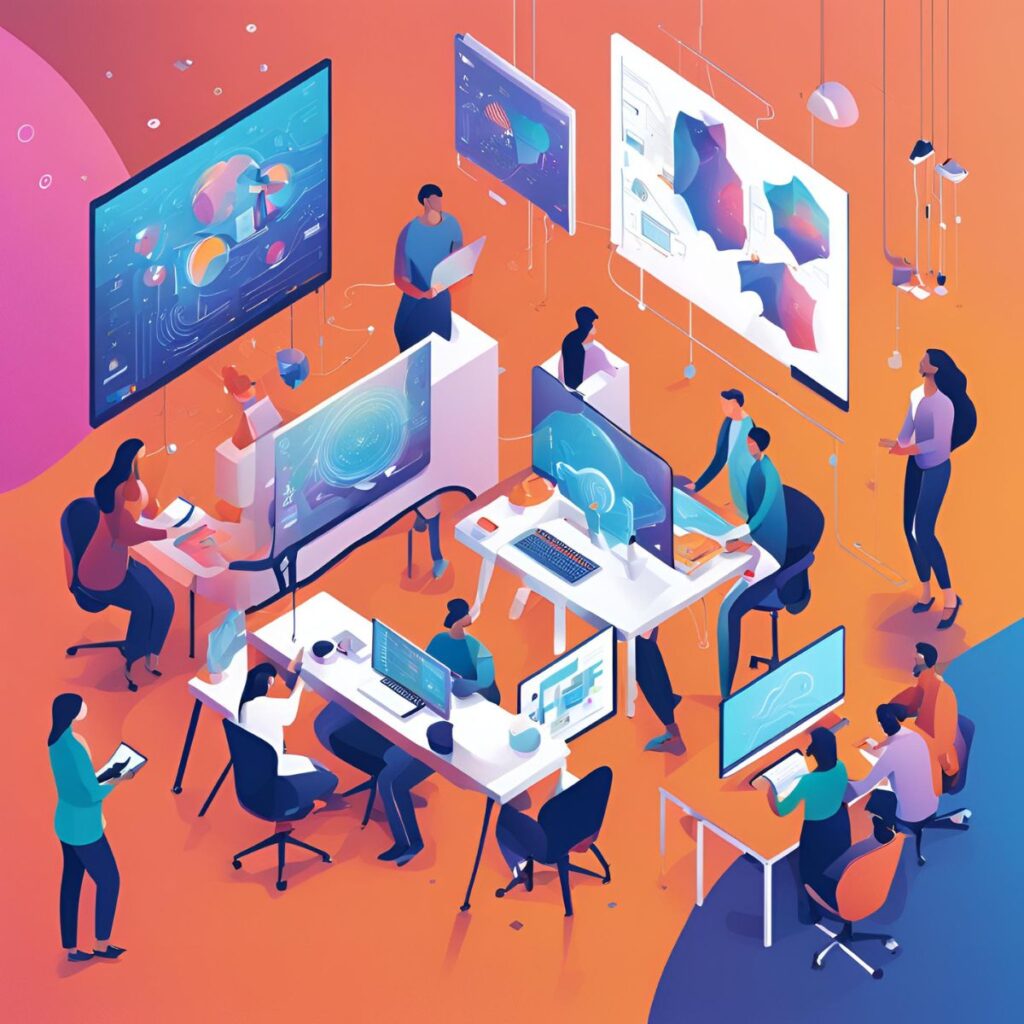
Exploring the Advantages of Generative AI in Business
Generative AI which belongs to the following category of artificial intelligence has revolutionized the idea of technology as it can be applied in many fields. By creating fresh data, content, and designs based on the initial already existing data, generative AI gives companies the power to come up with innovative ideas on how they can use this approach to save resources, while increasing effectiveness, customer satisfaction, and, at the same time, cut down on expenses. This article explores the benefits of generative AI in business, including the great potential of this technology to be able to help the employees to work significantly more efficiently, get to know the clients on a personal level and form products and ideas.
Enhancing Productivity and Automation
Generative Artificial Intelligence (AI) is a tool that enables businesses to administer and automate typically human requiring processes. Through automating activities like content creation, web design, and customer service, AI generative technologies help companies complete assignments in a precise manner and at a faster pace. Such is evident in:
- Automated Content Creation: Generative AI has the advantage of producing articles, product descriptions, reports instantly and thus it is saving the marketing and content teams time to concentrate on the strategy and creative tasks.
- Design and Prototyping: AI is capable of developing design possibilities or prototypes and can effectively reduce the time taken for development and product iteration. Less time and resources expended due to processes fade of these capacities and make available enhancement in productivity and allow staff to concentrate their attention on strategic operations.
Creating Personalized Customer Experiences
The effective Communication Technology (the AI) is transforming the customer experience by introducing customer-first personalization across the different business units. The AI models are processing the customer data to get to know in what way they want to be handled, what they are going to do next and based on that it can deliver them the consequent suggestions or instructions. The principal prototype problems that come about include:
- Dynamic Content Recommendations: Companies take advantage of this generative AI to help the individuals to determine the content and products they are most interested in.
- Chatbots and Virtual Assistants machines: AI-powered chatbots and virtual personal aids that can answer the consumer requirements in real-time, as well as providing to the user history and interaction based customization, have become the new reality.
Generating New Ideas and Innovative Products
AI generative technology can be the starting line for a new product or design innovation. It is achieved by deducing all possible ideas and products within the initial constraints. For example, a company could present a conceptual design to Generative AI, which could in turn generate dozens of different variations to help them come up with the most profitable solutions for the new products to be introduced.
Recreating original stuff: Becoming more innovative and developing new types of music, movies, advertising, fashion, and other potential fields is also another way in generative AI. Since generative-AI involves a focus on quality designs and therefore, the results can be purely unique, it definitely will not be forgotten in the future.
AI, by providing the possibility to change new strategies and technologies, provides companies with an excellent chance to accelerate their research and development efforts. As view the content of the input, AIs can also variate their ideas, not only by the theme that was implemented by the user but also by the users that ordered the AI.
Recreating original stuff: Becoming more innovative and developing new types of music, movies, advertising, fashion, and other potential fields is also another way in generative AI. Since generative-AI involves a focus on quality designs and therefore, the results can be purely unique, it definitely will not be forgotten in the future.
AI, by providing the possibility to change new strategies and technologies, provides companies with an excellent chance to accelerate their research and development efforts. As view the content of the input, AIs can also variate their ideas, not only by the theme that was implemented by the user but also by the users that ordered the AI.

Achieving Cost Savings and Efficiency
Generative AI can significantly decrease operational costs by streamlining and optimizing the workflow through reducing the exacerbation of manual tasks while increasing productivity. One example through which generative AI helps companies save expenses is as under:
- Reduced Manpower Expenses: Generative AI can be assigned such repetitive tasks as data collection and entry, freeing human labor and therefore reducing costs in a company.
- The Potential of Connected Systems: The knowledge is not owned by the consumers yet the global trading, as a result, can be well outsourced by the companies using the generative AI. It could help in managing the supply shortages through the generation of diverse parts to the system and thus, avoid the idleness of the stocks. This is, in turn, added to the advantages of the implementing of a connected system that includes the automations letting informating, decision making and execution being performed.
These cost-saving measures allow businesses to become more sustainable by using the financial benefits in additional strategic areas.
Improving Decision-Making Through Predictive Insights

The AI trained by feeding through the data becomes capable of detecting and predicting the patterns in the data which can then be used for decision-making. For instance, lets the system do the number crunching on its own, without any human intervention, and then come up with a forecast for the company on which activities are likely to be more profitable than others. This is where the company’s forecasting ability changes geometrically.
It will interpret this knowledge as the skill to identify which products have the best chances on the market. There is virtually no time for the discovery of new ideas here. The AI comes over with groundbreaking technologies and the ideas are stolen. Thus, these processes of forecast improvement and risk evaluation will lead to the production of better decisions and the establishment of future markets.
It will interpret this knowledge as the skill to identify which products have the best chances on the market. There is virtually no time for the discovery of new ideas here. The AI comes over with groundbreaking technologies and the ideas are stolen. Thus, these processes of forecast improvement and risk evaluation will lead to the production of better decisions and the establishment of future markets.
Trade-offs and Challenges
Even if the benefits are numerous them also companies may face some challenges along the way while using the generative AI technology. Here are the most common concerns:
Data Privacy and Security: Most of the time, generative AI models need a lot of sensitive data, which in its turn might hurt the reputation of a company. Privacy and security of the personal data are the most important issues for a company to avoid potential regulatory, and reputational issues.
Bias and Ethical Concerns: The models for generating AI are uninfluenced or unbiased in direct proportion with the information they are trained on. Unavailability of good quality or inherent bias in training datasets might tend to result in discrimination and unethical business outcomes. Cost of Implementation: Furthermore, there is a high initial investment in the generative AI infrastructure and talent. The companies need to know the tasks they are going to perform, the benefits to get and then the investment made will be of a long-term nature.
Data Privacy and Security: Most of the time, generative AI models need a lot of sensitive data, which in its turn might hurt the reputation of a company. Privacy and security of the personal data are the most important issues for a company to avoid potential regulatory, and reputational issues.
Bias and Ethical Concerns: The models for generating AI are uninfluenced or unbiased in direct proportion with the information they are trained on. Unavailability of good quality or inherent bias in training datasets might tend to result in discrimination and unethical business outcomes. Cost of Implementation: Furthermore, there is a high initial investment in the generative AI infrastructure and talent. The companies need to know the tasks they are going to perform, the benefits to get and then the investment made will be of a long-term nature.
Final Thought
The process of machine learning is also known as the Generative AI method. It allows businesses to automate processes which leads to efficiency and personalization of products and it also helps them produce new innovative products by making correct decisions. However, they can also be seriously considered as potential barriers to this technology enduring and growing such as data privacy and ethical concerns.Anyway, the potential benefits are much greater than its flaws. Generative AI is a key tool that businesses can use to stay competitive and agile in a fast-changing and digitalized world. Through the use of generative AI, businesses can become more competitive, achieve new growth opportunities, and provide better customer services.
Hello

